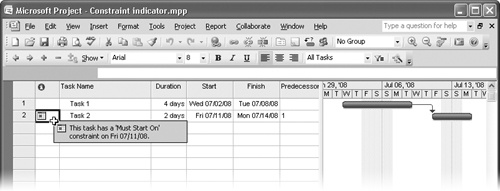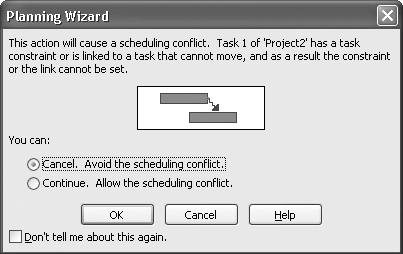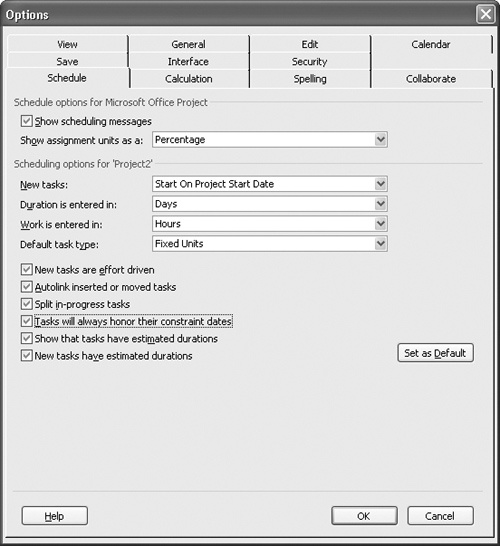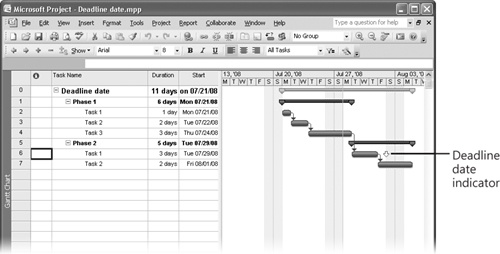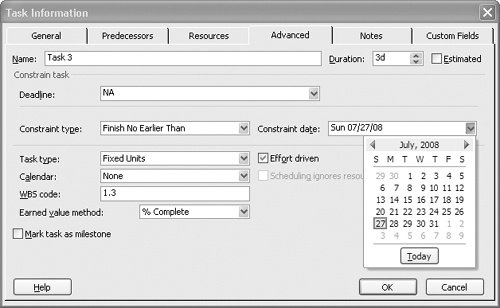So far in this chapter, you’ve seen how dependencies tie the timing of one task to the timing of another task. Dependencies alone do not determine the timing of a task. Unless you assign fixed start and finish dates for a task, Project determines the timing of a task using the task duration, calendars, dependencies, and constraints.
Warning
Should you assign start and finish dates to tasks? More often than not, no. If a task has immutable timing, such as a July 4 celebration on July 4th, use the Start and Finish fields. In most cases, however, you know how many work days you need to complete a task, but you don’t know when the work will be done. In these cases, supply a duration and let Project calculate the actual work dates based on the calendars, dependencies, and constraints.
Unlike dependencies, which tie the timing of one task to the timing of another task, constraints tie the timing of a task to the start or end of your project or to a specific date.
If you select Project Start Date in the Schedule From field of the Project Information dialog box discussed in 1, Project assigns, by default, an As Soon As Possible constraint to every task that you create. If you don’t set any dependencies for a particular task, it will, by virtue of the As Soon As Possible constraint, start on the first day of the project.
If you select Project Finish Date in the Schedule From field of the Project Information dialog box, Project assigns, by default, an As Late As Possible constraint to every task that you create. If you don’t set any dependencies for a particular task, it will, by virtue of the As Late As Possible constraint, finish on the last day of the project.
Note
Project sets the constraint automatically when you create a task, so changing the method of scheduling your project from Project Start Date to Project Finish Date, or vice versa, does not affect the constraint.
You can set other constraints:
If you set an As Late As Possible constraint, Project forces the task to start on the last date possible so that the task ends no later than the end of the project.
If you set a Finish No Earlier Than constraint or a Finish No Later Than constraint, Project makes sure that the task finishes no sooner or later than a date you supply.
If you set a Must Start On constraint or a Must Finish On constraint, Project forces the task to start or finish on a date you supply.
Finally, if you set a Start No Earlier Than constraint or a Start No Later Than constraint, Project makes sure that the task starts no sooner or later than a date you supply.
The Must Finish On constraint and the Must Start On constraint are inflexible constraints—sometimes called hard constraints—that force a task to start or end on a particular date. All of the other constraints are flexible constraints—sometimes called soft constraints—that force the task to occur within a certain time frame. This distinction is important, because soft constraints allow Project to change the start and finish dates of a task within the parameters of the constraint. Project cannot change the start or finish date of a task with a Must Start On or Must Finish On constraint.
Why do you care? You care because when you run into scheduling conflicts and have Project recalculate your schedule after you make changes to alleviate those problems, Project must work within the confines of all constraints you set. If you set any constraint other than As Soon As Possible or As Late As Possible, Project displays an icon in the Indicators column to alert you to the existence of the constraint. If you place your mouse pointer over the icon, Project displays a tip that describes the constraint (see 2-17).
Suppose that your company is moving into new offices that are currently being constructed. You’ve decided to move people into the offices in groups so that you can deal with problems that arise on a smaller scale without inconveniencing everyone. You’ve been told that the building will be complete on July 15, so you set up a task in your project to begin moving the first group of people on July 15—and you set a Must Start On constraint for that task; the moves of subsequent groups of people will depend on when the first group finishes moving.
In the new offices, each person will have a cubicle, and each cubicle needs to be assembled. You want the cubicles assembled before you move in the first group of people, so you set a finish-to-start relationship between Assemble Cubicles for Group 1 and Move Group 1. Let’s examine the possibilities that can occur if you go ahead and use that Must Start On constraint. Suppose that cubicle assembly finishes on July 10. In this case, you’ll sit around for five days doing nothing, because you can’t start the move, based on the Must Start On constraint, until July 15.
But what happens if cubicle assembly can’t begin until July 17? In this case, the constraint causes a conflict with the dependency timing, and Project displays a Planning Wizard dialog box to let you know (see 2-18).
It’s important to understand that Project, by default, views constraints as more important than dependencies. If, while calculating your schedule, Project must choose between honoring a constraint and honoring a dependency, Project will honor the constraint. You can change this behavior and make Project honor dependencies over constraints. On the Tools menu, click Options, and click the Schedule tab (see 2-19). Then clear the Tasks Will Always Honor Their Constraint Dates check box.
A better approach, however, is to avoid setting constraints unless they are absolutely necessary. In this example, you might consider using a deadline date instead of a constraint.
Suppose that you’re closing the local office and offering severance packages to employees who don’t relocate. If an employee chooses to relocate, you need to make all the arrangements for the employee to move. If an employee opts to leave the company, you need to make the financial arrangements for the severance package.
After you identify all of the tasks associated with relocating and preparing severance packages, you can determine the date by which you must have an answer from each employee. Setting a Must Finish On constraint for the Evaluate Employee Responses task would be appropriate to ensure that you close the local office on time.
Using dependencies, though, truly is the best technique to get an accurate idea of the length of your project. By their very nature, constraints introduce timing factors into your project that might be artificial.
Project doesn’t use deadline dates when calculating the project schedule for tasks with the As Soon as Possible constraint, so deadlines don’t really affect the timing of tasks or of your project. They are instead visual indicators that appear in the chart portion of the Gantt Chart view to help you identify a date important to your project. For example, in the Office Move scenario, you might set the expected starting date for the move—July 15—as a deadline date.
The deadline date indicator appears as a downward pointing arrow on the date you set for the deadline; in 2-20, the deadline date for Task 1 in Phase 2 (on Row 6 of the project) is August 1, and you can see the arrow in the chart portion beside the Gantt bar. You can place your mouse over the deadline date indicator to see a tip containing the deadline date information (I didn’t show this in the figure, because the tip would have blocked the deadline indicator).
Figure 2-20. The deadline date indicator, a downward pointing arrow, appears in the chart portion of the Gantt Chart view on the date set for the deadline.
If the task finishes after the deadline date, Project displays an icon in the Indicators column to alert you that you missed the deadline.
Note
Project doesn’t display an icon in the Indicators column if you complete the task prior to the deadline date.
Although in most cases Project doesn’t use deadline dates when calculating a project schedule, deadline dates do affect a Late Finish date and the calculation of total slack for the project. In a project that you schedule from a beginning date, a deadline date has the same effect as a Finish No Later Than constraint when Project calculates slack. If you assign deadline dates to tasks in projects that you schedule from an ending date, those tasks will finish on their deadline dates unless a constraint or a dependency pushes them to an earlier date.
You can set constraints and deadline dates on tasks in your project from the Advanced tab of the Task Information dialog box (see 2-21).
Figure 2-21. Set both constraints and deadline dates from the Advanced tab of the Task Information dialog box.
To set a constraint for a particular task, double-click the task, click the Advanced tab, and select a constraint type from the Constraint Type list. For all constraints other than As Late As Possible and As Soon As Possible, designate a date by selecting a date from the calendar that appears when you click the arrow in the Constraint Date field.
Set a deadline date by clicking the arrow next to the Deadline field and choosing a date from the calendar that appears.

